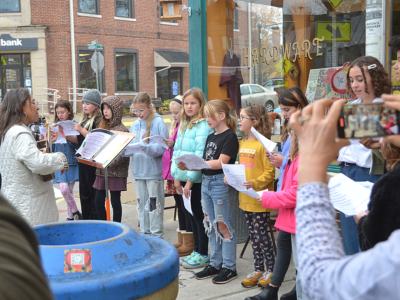Green space funds waning
- Published: May 10, 2012
A state program used to preserve area farmland for a decade has been halted, hindering a local land trust’s efforts to protect land from development. The Tecumseh Land Trust, which has received more than $11 million from Clean Ohio to purchase conservation easements in Greene and Clark Counties, is now filing away applications from landowners wishing to sell their development rights.
Krista Magaw, executive director of the Tecumseh Land Trust, called the situation urgent, and worried that landowners might lose interest.
“Every month that goes by without Clean Ohio funding, many good projects are lost,” Magaw told the Ohio Senate Finance Committee at a hearing last month.
Clean Ohio is a $400 million state bond initiative passed by voters in 2000 to support brownfield revitalization, preserve farmland and open space and build trails. In 2008 it was re-authorized by 70 percent of Ohio voters and won majority support in all 88 counties.
But the state has only issued bonds for $100 of the $200 million of the fund aimed at conservation and trails, while brownfield re-development has been fully funded. Funding for green space is two years behind, slowing down the efforts of groups like the Tecumseh Land Trust, which has used the money to purchase easements on 53 nearby farms and natural areas since 2002.
In fact, the land trust has used Clean Ohio funds in about two-thirds of all its purchased easements in the last decade, according to Magaw, and used them to leverage additional money from the Federal Farm and Ranchland Protection Program and local municipalities and townships. In 2012, the Village of Yellow Springs allocated $50,000 to farmland preservation.
Magaw urged lawmakers to include Clean Ohio funding in a recent state budget hearing before the Ohio Senate Finance Committee. Magaw said that Clean Ohio helps farmers grow their business and keeps costs down for financially-stressed municipalities and explained the consequences of delaying funding.
“It often takes years for landowners to consider their options and make a decision as to what to do with family land,” Magaw said. “But when elders pass away, the decision-making dynamic changes completely. The educational process has to start all over again, often with many more family decision makers, some of who may not even live in Ohio.”
Area farmer and land trust board member Jim Timmons said that Ohioans who voted for the measure are being “short changed.” Timmons, who farms preserved properties in Clark County, is frustrated by the delay because it takes years to convince landowners that preserving their farm doesn’t mean they give up ownership.
“As a farmer I would love to rent a farm that has an easement on it because as long as I’m good to the landowner that will always be farm ground,” Timmons said.
The Senate Finance Committee, chaired by local senator Chris Widener, decided last month to not include Clean Ohio funding in its two-year capital budget proposal. Meanwhile, the trails program of Clean Ohio received a modest $6 million.
Josh Knights, executive director of the Ohio branch of the Nature Conservancy, which co-led Clean Ohio renewal efforts in 2008, said the loss of funding has been huge.
“What people lose track of is green field preservation is extremely important to make Ohio competitive with other states in terms of quality of life,” Knights said. “Of the top 10 cities in the country that have lost young professionals, six of the 10 are in Ohio.”
Because of the conservation programs of Clean Ohio, 40,000 acres of family farms and 26,000 acres of natural areas have been protected and more than 220 miles of recreational trails completed, Knights said. While these accomplishments have enhanced livability in the state, brownfield re-development has generated $2.6 billion in economic impact for Ohio, Knights added. One nearby project benefitting from funds was the Springfield Regional Medical Center, built on an abandoned lot in downtown Springfield.
Other funding sources for conservation efforts are drying up, too. A federal tax benefit whereby farmers could deduct the appraised easement value for up to 16 years expired at the end of 2011. And last year Gov. John Kasich eliminated the estate tax. Previously the first $50,000 in state estate tax revenues that came to the Village of Yellow Springs went into their greenspace fund, up to a cap of $250,000. Miami Township devoted the entire amount of estate taxes coming to them up to $103,000 for area farmland preservation. Though some estate tax monies will continue to trickle in throughout 2012, by next year that funding will be gone.
However, one funding source is growing. The Federal Farm and Ranchland Protection Program of the U.S. Department of Agriculture’s Natural Resources Conservation Service increased its funding to Ohio farms from $3 million in 2010 to $12 million in 2011. Last year the Tecumseh Land Trust applied for and was awarded $1.6 million to purchase 17 farm easements, five of them in Miami Township.
In fact, since 2004, the Tecumseh Land Trust has received more USDA awards than any of the state’s other 40 land trusts. But a 25 percent non-federal cash match is required, so the local or state funds are still needed. Without the match money, Magaw is concerned that the funding will fall below a critical threshold, even while interest in farmland preservation is on the rise.
“The non-farm population is more in touch than ever with the desire to be stewards of the land,” Magaw said. “We’ve been able to be so efficient with great local support and interest that it’s enabled us to reach out to landowners.”
In its 22 years, the land trust has preserved 22,000 acres of land in Clark and Greene Counties and aims to preserve 100,000 acres to anchor agriculture in the area. Last year 17 properties were preserved.
Ordinarily the Tecumseh Land Trust would have submitted the 20 best scoring of its 60 or more possible applications to Clean Ohio, hoping to get one to three funded. Tecumseh Land Trust will close on 17 already-funded easement projects this year or next year and, within a couple more years seeks to purchase an easement on the entire Glen Helen. Funding from the U.S. Environmental Protection Agency has already been awarded for protection of the 2.5 miles of the Little Miami River.
The land trust could work to raise more private dollars to compensate for the loss of government funding, but the thought of sustaining the kind of community-wide effort that helped preserve the 1,000-acre Whitehall Farm north of Yellow Springs is hard to imagine, Magaw said.
“It would be really difficult if we had to raise private money to do what we do,” she said.














No comments yet for this article.